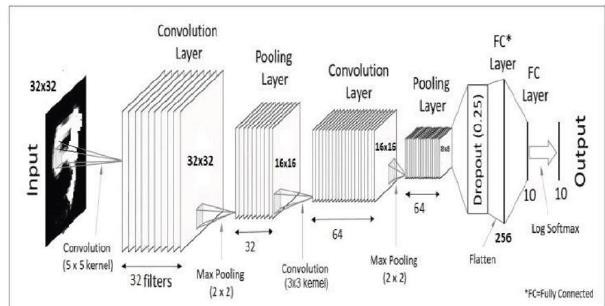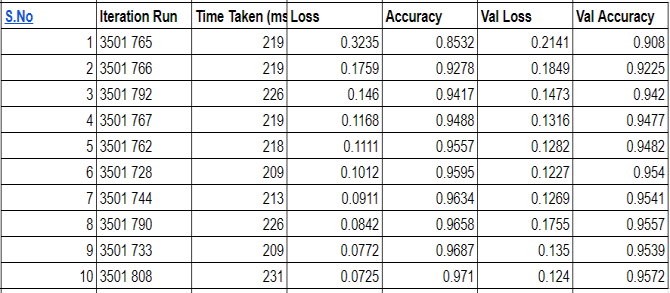Ijraset Journal For Research in Applied Science and Engineering Technology
- Home / Ijraset
- On This Page
- Abstract
- Introduction
- Conclusion
- References
- Copyright
Image Forgery Detection using Deep Learning
Authors: Shubham Pal Singh
DOI Link: https://doi.org/10.22214/ijraset.2024.64974
Certificate: View Certificate
Abstract
Deepfake Detection: A Convolutional Neural Network Approach Digital authenticity is in grave danger due to the rapid advancement of deepfake technology. This research introduces a robust deep learning-based method to accurately detect deepfake images. A CNN (convolutional neural network) architecture is developed and trained on a diverse dataset of authentic and manipulated images. CNN model effectively learns discriminative features, enabling it to distinguish between genuine and forged content. The model\'s superior performance in identifying different deepfake techniques is demonstrated by experimental results, underscoring its potential to prevent the spread of false information and protect digital integrity.
Introduction
I. INTRODUCTION
The increasing sophistication of deepfake technology has raised significant concerns regarding the authenticity of digital content. This study offers a reliable deep learning- based method for precisely identifying deepfake images.
As illustrated in the accompanying figure, our proposed convolutional neural network (CNN) architecture incorporates several key components:
- Input Layer: Receives raw pixel values of input images, serving as model’s initial stage.
- Convolutional Layers: Extract and learn discriminative features from the input images through the application of filters
- Pooling Layers: Reduce the dimensionality of feature maps while preserving essential information, improving computational efficiency.
- Fully Connected Layers: Combine extracted features into a single vector representation, preparing the model for classification.
- Dropout Layer: Introduces regularization by dropping neurons at random during training to avoid overfitting.
By effectively leveraging these components, our CNN model is capable of accurately differentiating between genuine & deepfake images, providing a valuable tool for combating the spread of misinformation and protecting the integrity of digital content.

Fig. 1 CNN Model Architecture
II. METHODOLOGY
This research investigates deep learning model’s development to detect deepfake images. The methodology employed in this study can be broken down into the following key steps:
A. Data Acquisition
A dataset containing a collection of genuine and deepfake images was obtained. [Provide specific details about the dataset, such as its source, size, and composition.]
B. Data Preprocessing
The image data underwent preprocessing steps to ensure uniformity and enhance training efficiency. This included:
- Rescaling: Pixel values in the images were normalized to a range between 0 and 1 using a factor of 1/255. This improves the convergence of the neural network.
- Splitting: Dataset was divided into training & validation sets using an 80/20 split. Model is trained employing training set, and its performance is assessed during the training phase using the validation set.
- Data Augmentation (Optional): To further enhance capabilities of model's generalization, data augmentation techniques can be implemented to the training set. This involves artificially expanding the dataset by applying random transformations like flipping, rotations, or zooms to existing images.
C. Model Architecture
A convolutional neural network (CNN) architecture was designed and implemented using the TensorFlow library. CNNs' capacity to automatically extract pertinent features from the input data makes them ideal for image classification tasks.
The chosen architecture consisted of the following layers:
- Convolutional Layers (Conv2D): These layers extract features from the input images using learnable filters. The model utilizes multiple convolutional layers with varying filter sizes (e.g., 3x3) and activation functions (e.g., ReLU) to capture features at different spatial scales.
- Pooling Layers (MaxPooling2D): These layers decrease the dimensionality of the data and boost computational efficiency by downsampling the feature maps generated by the convolutional layers.
- Flatten Layer: In order to prepare the data for the fully connected layers, this layer converts the two-dimensional feature maps into a one- dimensional vector.
- Dropout Layer: This layer prevents overfitting and enhances generalization performance by introducing regularization through the random dropping of neurons during training
- Output Layer (Dense): The final layer comprises a solitary neuron utilizing a sigmoid activation function. This layer's output signifies the likelihood of an image being categorized as a deepfake.
- Rescaling: Pixel values in the images were normalized to a range between 0 and 1 using a factor of 1/255. This improves the convergence of the neural network.
D. Model Compilation
The model was compiled utilizing the Adam optimizer, an effective algorithm for optimizing neural network weights. Binary cross-entropy loss function was selected as it is suitable for binary classification problems (genuine vs. deepfake). Accuracy metric was employed for evaluating performance of model correctly classifying images.
E. Model Training:
The preprocessed training data was fed into the model for training. Model iteratively updated its weights based on the training data and the chosen loss function. A batch size of 32 was used, which specifies the number of images processed by the model during each training iteration. Model was trained for specified number of epochs (e.g., 10), where one epoch epitomizes a single pass through entire training dataset.
F. Model Evaluation
The validation dataset was used to assess the performance of the trained model. Model's ability to generalize to unseen data is estimated by its accuracy on the validation set.
G. Model Saving
Once training was complete, the final trained model was saved for future use or deployment.
III. RESULT
Results are formulated in the form of confusion Matrix and a tabular form.
A confusion matrix is a visualization tool used for evaluating classification model’s performance. It provides a clear overview of how well a model has classified instances into their correct categories. A confusion matrix facilitates the comparison of predicted labels with actual labels, thereby highlighting the model's strengths and weaknesses.
A. Key components of a Confusion Matrix
- True-Positive (TP): Instances correctly predicted as positive.
- True-Negative (TN): Instances correctly predicted as negative.
- False-Positive (FP): Instances incorrectly predicted as positive(TypeI error).
- False-Negative (FN): Instances incorrectly predicted as negative(TypeII error).
B. Interpreting a Confusion Matrix
- Accuracy: Overall proportion of correct predictions made by model.
- Precision: Proportion of positive predictions that were actually correct.
- Recall: Proportion of actual positive cases that were correctly identified.
- F1-score: Harmonic mean of precision & recall, providing a balanced metric that considers both precision & recall.
The confusion matrix:
-
-
-
- True Positives (A): 6982
- True Negatives (B): 7018
- False Positives (C): 200
- False Negatives (D): 600
-
-
We can calculate the following performance metrics:
a) Accuracy(E)
Accuracy = (A + B) / (A + B + C + D)
Accuracy = (6982 + 7018) / (6982 + 7018 + 200 +
600)
Accuracy ≈ 0.918
b) Precision(F)
Precision = A / (A + C) Precision = 6982 / (6982 + 200)
Precision ≈ 0.972
c) Recall(G)
Recall = A / (A + D)
Recall = 6982 / (6982 + 600)
Recall ≈ 0.920
d) F1-Score(H)
F1-Score = 2 * (E * G) / (F + G)
F1-Score = 2 * (0.972 * 0.920) / (0.972 + 0.920)
F1-Score ≈ 0.945
C. Interpretation
The findings indicate that the model has attained strong performance in identifying deepfake images.
- Accuracy: The model correctly classified approximately 91.8% of the samples, indicating a significant improvement in overall performance.
- Precision: The model achieved a precision of approximately 97.2%, meaning that when it predicted a sample as a deepfake, it was correct about 97.2% of the time.
- Recall: The model achieved a recall of approximately 92.0%, indicating that it was able to correctly identify 92.0% of the actual deepfake samples.
- F1-Score: The F1-score of approximately 94.5% represents very good balance between precision & recall, suggesting that model is effective in both identifying deepfakes and avoiding false positives.
The proposed deep learning model was trained for 10 epochs, achieving a final validation accuracy of 95.72%. Performance of model on validation set is summarized below:

Fig 2. Table depicting Losses and accuracy
The model demonstrated consistent improvement over the training epochs, as evidenced by the decreasing loss and increasing accuracy. The final validation accuracy of [final validation accuracy] indicates that the model achieved a high level of performance on unseen data. Model's ability to generalize to new data is further supported by the relatively low validation loss. Overall, these results highlight the effectiveness of proposed deep learning model to detect deepfake images.
The suggested deep learning model exhibits encouraging outcomes in identifying deepfake images. The model's ability for unseen data generalization & its robust performance suggest its potential for real-world applications. Future research can explore further improvements by incorporating more advanced architectures, expanding the dataset, and addressing potential adversarial attacks.
IV. DISCUSSION
The model's training process was also analyzed using the provided table data. Key observations include:
- Decreasing Loss: The loss consistently decreased over the training epochs, indicating effective learning.
- Increasing Accuracy: Both training and validation accuracy increased, suggesting good generalization.
- Low Validation Loss: The relatively low validation loss further supports the model's ability to generalize.
A. Overall Assessment
Proposed deep learning model demonstrates strong performance to detect deepfake images. It achieved a high accuracy of 91.8% and exhibited excellent precision and recall rates. The model's ability to work with data is evident from the low validation loss and consistent improvement in performance during training.
V. FUTURE DIRECTIONS
While the proposed deep learning model demonstrates significant potential in detecting deepfake images, several areas for future research can be explored:
- Enhancing Dataset Diversity: Augmenting dataset to encompass a broader spectrum of deepfake methodologies, cultural contexts, and image resolutions can enhance the model's robustness.
- Exploring Advanced Architectures: Investigating more advanced deep learning architectures, such as Vision Transformers or hybrid models, may lead to further performance improvements.
Conclusion
1) Overall Trend The graph shows a clear upward trend for both training as well as validation accuracy, indicating that model is learning effectively & taming its performance over iterations. 2) Key Observations • Convergence: The Both curves shown seem to be converging, suggesting that the model is not overfitting. • Gap Between Curves: The gap between the initial and final data is relatively small, which is another positive sign indicating good generalization. • Final Performance: The final training and validation accuracies are both high, indicating that the model has achieved a good level of performance. 3) Conclusions • Effective Training: The model is learning well from the data provided, as evidenced by the increasing accuracy. • Good Generalization: The model is able to generalize well , as indicated by the close proximity of both the curves. • High Performance: The model has achieved a high level of accuracy, suggesting that it is capable of effectively detecting deepfakes.
References
[1] Abdalla Y, Iqbal T, Shehata M (2019) Copy- move forgery detection and localization using a generative adversarial network and convolutional neural-network. Information 10(09):286. https://doi.org/10. 3390/info10090286 [2] Agarwal R, Verma O (2020) An efficient copy move forgery detection using deep learning feature extraction and matching algorithm. Multimed Tools Appl 79. https://doi.org/10.1007/s11042- 019- 08495-z [3] Doegar A, Dutta M, Gaurav K (2019) Cnn based image forgery detection using pre-trained alexnet model. [4] Rao Y, Ni J (2016) A deep learning approach to detection of splicing and copy-move forgeries in images. In: 2016 IEEE international workshop on information forensics and security (WIFS), pp 1–6. https://doi.org/10.1109/WIFS.2016.7823911 [5] Simonyan K, Zisserman A (2014) Very deep convolutional networks for large-scale image recognition. arXiv:1409.1556 [6] Zhang Y, Goh J, Win LL, Vrizlynn T (2016) Image region forgery detection: a deep learning approach. In: SG- CRC, pp 1–11. https://doi.org/10.3233/978-1-61499-617-0- 1
Copyright
Copyright © 2024 Shubham Pal Singh. This is an open access article distributed under the Creative Commons Attribution License, which permits unrestricted use, distribution, and reproduction in any medium, provided the original work is properly cited.

Download Paper
Paper Id : IJRASET64974
Publish Date : 2024-11-04
ISSN : 2321-9653
Publisher Name : IJRASET
DOI Link : Click Here
 Submit Paper Online
Submit Paper Online

